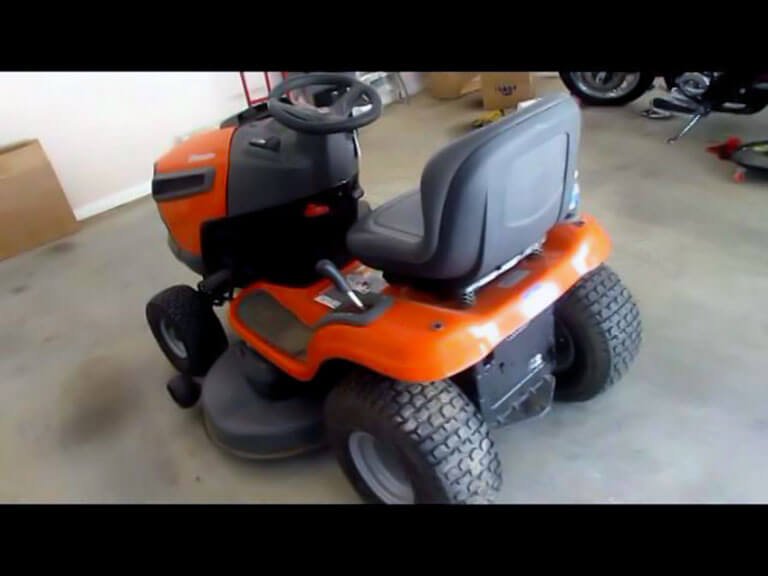Husqvarna Riding Mower Transmission Problems: Quick Fixes
Husqvarna riding mower transmission problems often stem from issues with the drive belt or hydraulic system. Regular maintenance can help prevent these issues and ensure smooth operation.
Husqvarna riding mowers are popular for their efficiency and reliability in lawn care. However, like any machine, they can experience transmission problems that hinder performance. Identifying these issues early can save time and money on repairs. Common symptoms include unusual noises, difficulty shifting gears, or the mower not moving at all.
Understanding the root causes of these problems is essential for effective troubleshooting. Regular maintenance, such as checking the drive belt and fluid levels, can significantly reduce the likelihood of transmission failures. Keeping your mower in top condition ensures a well-manicured lawn and prolongs the life of your machine.
Introduction To Common Transmission Issues

Husqvarna riding mowers are reliable machines. Yet, they can face transmission problems. Understanding these issues helps in early detection. This can save time and money. Here, we explore common symptoms and impacts of transmission problems.
Symptoms Of A Troubled Transmission
Identifying transmission issues early is crucial. Here are common symptoms:
- Slipping Gears: The mower unexpectedly changes speed.
- Unresponsive Controls: The controls do not respond as expected.
- Strange Noises: Grinding or clunking noises during operation.
- Vibrations: Excessive shaking while mowing.
- Fluid Leaks: Puddles of oil or fluid under the mower.
Impact Of Transmission Problems On Mowing Efficiency
Transmission issues can greatly affect mowing efficiency. Here are the main impacts:
| Impact | Description |
|---|---|
| Reduced Speed | Mower may move slower than normal. |
| Uneven Cutting | Grass may be cut unevenly, leading to a patchy lawn. |
| Increased Fuel Consumption | More fuel may be used due to inefficiency. |
| Extended Mowing Time | More time is needed to complete mowing tasks. |
These impacts can lead to frustration and wasted resources. Addressing transmission issues promptly is essential for optimal performance.
Identifying Your Husqvarna Model
Understanding your Husqvarna riding mower’s model is crucial for troubleshooting. Each model has specific transmission types. Knowing your model helps in diagnosing transmission problems effectively.
Different Transmission Types
Husqvarna riding mowers use various transmission types. Here are the main ones:
| Transmission Type | Description |
|---|---|
| Hydrostatic | Uses hydraulic fluid for smooth operation. Ideal for varied terrain. |
| Gear Drive | Offers manual control with gear shifting. Suitable for flat lawns. |
| Automatic | Adjusts speed based on load. Simple and easy to use. |
Locating Model And Transmission Information
Finding your Husqvarna model and transmission type is simple.
- Check the owner’s manual.
- Look for a sticker under the seat.
- Inspect the frame near the engine.
Write down the model number. This number helps in searching for parts and repair guides.
- Access the manual online.
- Contact customer support for assistance.
- Visit the official Husqvarna website.
Keep this information handy. It will save you time during repairs.
Basic Troubleshooting Steps
Facing transmission problems with your Husqvarna riding mower? Start with basic troubleshooting steps. These steps help identify common issues quickly. Follow them to get your mower back in shape.
Checking Transmission Fluid Levels
Low transmission fluid can cause serious issues. Always check the fluid levels first. Here’s how:
- Locate the transmission dipstick.
- Pull out the dipstick and wipe it clean.
- Reinsert the dipstick and remove it again.
- Check the fluid level on the dipstick.
Fluid levels should be between the “Full” and “Add” marks. If the fluid is low, add the recommended type:
| Fluid Type | Recommended Brand |
|---|---|
| Hydraulic Fluid | Husqvarna OEM |
| Transmission Oil | Synthetic 10W-30 |
Check for leaks around hoses and connectors. Fix any leaks before adding fluid.
Inspecting For Obvious Damage
Physical damage can cause transmission issues. Inspect your mower carefully. Look for:
- Cracks in the transmission housing.
- Bent or broken drive shafts.
- Loose or damaged belts.
Use a flashlight for better visibility. Pay attention to any unusual sounds while operating the mower. These can indicate deeper problems.
Document any damage. This information helps in repairs or when seeking professional help.
Simple Fixes You Can Do
Husqvarna riding mower transmission problems can be frustrating. Luckily, some simple fixes can help. Try these DIY solutions to get your mower back on track.
Adjusting The Drive Belt
The drive belt plays a vital role in your mower’s function. A loose or damaged belt can lead to transmission issues. Here’s how to adjust it:
- Turn off the mower and disconnect the spark plug.
- Locate the drive belt on the mower.
- Check for wear or damage.
- Adjust the tension using the adjustment bolts.
- Reassemble any covers and reconnect the spark plug.
Ensure the belt is tight but not overly stretched. A properly adjusted belt improves performance.
Purge Air From The Transmission System
Air trapped in the transmission can cause shifting problems. Purging the system is a simple fix:
- Start the mower and let it run for a few minutes.
- Engage the drive lever while parked.
- Slowly release the lever and listen for air escaping.
- Repeat this process until you hear no more air.
Removing air helps ensure smooth operation. Regular maintenance prevents future issues.
Dealing With Gear Problems
Gear problems in Husqvarna riding mowers can disrupt your lawn care routine. Understanding how to address these issues is crucial. Proper maintenance and timely repairs can save you time and money.
Shifting Issues And Solutions
Shifting issues are common in riding mowers. These problems can make mowing frustrating. Here are some common shifting issues and their solutions:
- Stiff Shifting: Check the cable for wear. Lubricate the cable if necessary.
- Slipping Gears: Inspect the transmission fluid level. Replace fluid if it’s low.
- Unresponsive Shifter: Tighten any loose connections. Replace worn parts promptly.
- Grinding Noises: Check for debris in the gears. Clean any obstructions carefully.
Regular checks can prevent serious issues. Always consult your owner’s manual for guidance.
When To Replace The Gear Assembly
Knowing when to replace the gear assembly is vital. Here are some signs that indicate a replacement is needed:
| Sign | Description |
|---|---|
| Excessive Noise | Loud grinding or clunking sounds during operation. |
| Fluid Leaks | Visible fluid under the mower indicates a problem. |
| Frequent Gear Slippage | The mower frequently loses power while in gear. |
| Difficulty Shifting | Shifting becomes increasingly difficult over time. |
Replacing the gear assembly can restore performance. Consult a professional for accurate diagnostics.
Hydrostatic Transmission Hitches
Hydrostatic transmission hitches are common issues with Husqvarna riding mowers. These problems affect the mower’s performance. Understanding the causes and solutions can save time and money.
Understanding Hydrostatic Transmission
Hydrostatic transmission uses fluid to transfer power. It offers smooth operation and speed control. Here are key components:
- Pump: Moves hydraulic fluid.
- Motor: Converts fluid power into mechanical power.
- Fluid: Essential for operation. Low fluid levels cause issues.
Common signs of problems include:
- Sluggish acceleration
- Inconsistent speed
- Strange noises while operating
Resolving Hydrostatic Issues
Fixing hydrostatic transmission issues requires careful steps. Follow this guide:
| Problem | Solution |
|---|---|
| Low Fluid Level | Check and refill with recommended fluid. |
| Dirty Filters | Clean or replace filters regularly. |
| Air in the System | Bleed the system to remove air. |
| Worn Components | Inspect and replace worn parts. |
Regular maintenance helps prevent problems. Check fluid levels often. Replace filters as needed. Early detection ensures smooth operation.
Maintenance Tips To Prevent Future Issues
Proper maintenance is key to avoiding Husqvarna riding mower transmission problems. Regular care helps extend the life of your mower. Follow these tips for a smoother mowing experience.
Regular Transmission Check-ups
Check your transmission regularly. Catching issues early can save you money and time. Here’s what to do:
- Inspect fluid levels monthly.
- Look for leaks or damage.
- Listen for unusual noises during operation.
Keep an eye on the transmission performance. Poor performance can signal trouble. Address problems quickly to avoid bigger issues.
Best Practices For Longevity
Use these best practices to maintain your mower’s transmission:
- Change transmission fluid every 100 hours of use.
- Keep the mower clean. Remove grass clippings and dirt.
- Store the mower in a dry place.
Consider a protective cover for your mower. This shields it from the elements. Follow the manufacturer’s guidelines for maintenance. This ensures the best care for your Husqvarna mower.
| Action | Frequency |
|---|---|
| Fluid Inspection | Monthly |
| Fluid Change | Every 100 hours |
| Clean Mower | After each use |
Regular maintenance keeps your mower running smoothly. A well-maintained transmission improves efficiency. These steps help prevent future issues.
When To Seek Professional Help
Husqvarna riding mowers are reliable machines. They can face transmission issues over time. Recognizing these problems early can save you time and money. Knowing when to seek professional help is essential. Here’s how to identify complex issues and find the right technician.
Recognizing Complex Transmission Problems
Some transmission problems are easy to spot. Others require a trained eye. Look out for these signs:
- Strange Noises: Clunking or grinding sounds can signal trouble.
- Slipping Gears: If the mower jumps out of gear, it’s a concern.
- Slow Response: Delays in speed changes may indicate a problem.
- Fluid Leaks: Any fluid pooling under the mower needs attention.
- Burning Smell: A burnt odor could mean overheating.
Ignoring these signs may lead to bigger issues. Regular maintenance helps prevent these problems.
Finding A Qualified Technician
Finding the right technician is crucial. Follow these steps to ensure you choose wisely:
- Check Reviews: Look for local shops with positive feedback.
- Ask for Recommendations: Friends or family may know trusted professionals.
- Verify Certifications: Ensure the technician is certified to work on Husqvarna mowers.
- Request Estimates: Get quotes from multiple technicians for comparison.
- Inquire About Experience: Choose someone with a solid track record in mower repairs.
Hiring a qualified technician can restore your mower’s performance. Avoid DIY repairs unless you’re confident in your skills.
Frequently Asked Questions
What Causes Husqvarna Riding Mower Transmission Issues?
Transmission problems often stem from low fluid levels, worn belts, or faulty components.
How To Identify Transmission Problems In Husqvarna Mowers?
Signs include unusual noises, slipping gears, or the mower not moving as expected.
Can I Fix Husqvarna Mower Transmission Myself?
Basic issues like belt replacements can be DIY, but complex repairs may require professional assistance.
How Often Should I Service The Transmission?
Regular maintenance every 50 hours of use helps prevent transmission problems and extends the mower’s lifespan.
Where Can I Find Husqvarna Mower Transmission Parts?
Official Husqvarna dealers, authorized retailers, and online marketplaces offer a variety of transmission parts.
Conclusion
Addressing Husqvarna riding mower transmission problems early can save you time and money. Regular maintenance and prompt repairs can enhance performance and longevity. Always consult your user manual for specific guidance. With the right care, your mower can provide reliable service season after season.
Keep your lawn looking great with a well-functioning mower.





